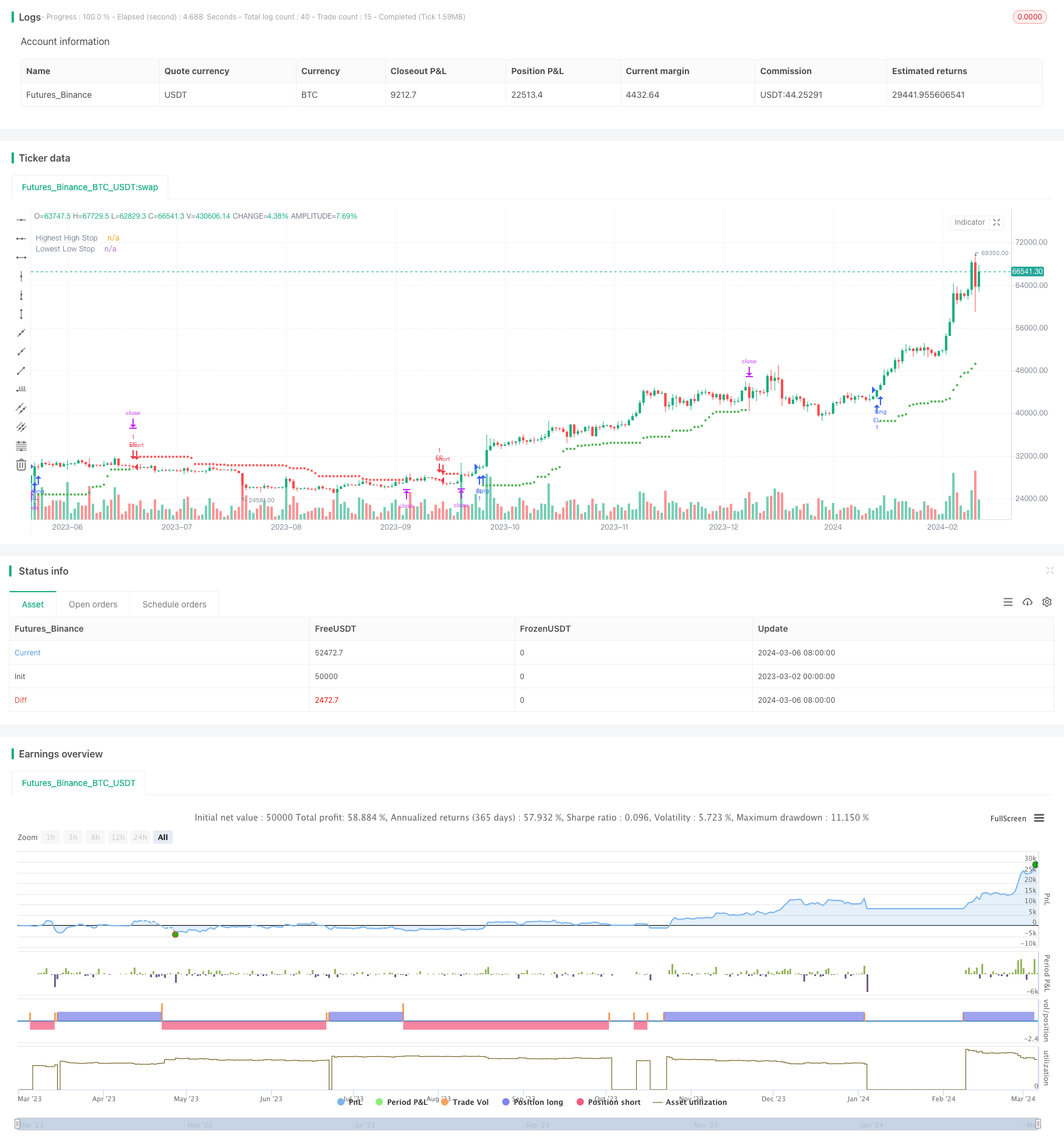
概述
该策略基于近期最高价和最低价设置止损点,以快速切入趋势并严格控制风险。当价格出现连续上涨时开多单,连续下跌时开空单。持仓时,多单止损位置为最近几根K线的最低价,空单止损位置为最近几根K线的最高价。这种动态止损方式能高效捕捉趋势,同时严格限制损失。
策略原理
- 通过
input函数设置最高价和最低价参考周期hiLen和loLen,默认为20。 - 用
ta.highest(high, hiLen)[1]计算前一根K线为止的最高价hiHighs,用ta.lowest(low, loLen)[1]计算前一根K线为止的最低价loLows。 - 画出止损位置,多单止损位置为
loLows,空单止损位置为hiHighs,不持仓时不画,方便直观确认。
- 定义交易信号条件:
- 最近3根K线收盘价连续上涨为
higherCloses - 最近3根K线收盘价连续下跌为
lowerCloses - 当前无持仓为
isFlat
- 最近3根K线收盘价连续上涨为
- 开仓:满足
isFlat和higherCloses时开多单,满足isFlat和lowerCloses时开空单。 - 止损:多单持仓时,止损价格为
loLows,空单持仓时,止损价格为hiHighs。
简言之,该策略用近期最高最低价设置移动止损,快速切入强劲趋势并严格限损,能高效捕捉趋势收益。
优势分析
- 简单有效:该策略逻辑清晰简单,基于价格本身设置止损,能有效捕捉趋势。
- 快速切入:连续三根K线同向运动即可开仓,能快速切入新趋势。
- 止损严格:止损位置为近期最高价或最低价,与当前价格紧密相关,风险控制严格。
- 移动止损:止损位置会随着价格不断更新,既能锁定利润,又能保留趋势空间。
- 适应性强:适用于各类市场与品种,参数也可灵活调整。
风险分析
- 震荡市风险:震荡市场会导致频繁开仓止损,策略表现不佳。解决办法是避开震荡市,或增大开仓条件以过滤。
- 趋势末期风险:当趋势即将反转时,有可能刚开仓就遇到反转,导致亏损。解决办法是配合趋势判断指标,及时了结。
- 极端行情风险:极端超跌反弹或超涨杀跌时,移动止损可能无法很好地保护头寸。解决办法是设置固定止损位。
- 参数风险:参数设置不当会导致开仓止损过于频繁。解决办法是做好参数优化。
优化方向
- 趋势判断:增加趋势判断指标,如均线,只在大趋势方向开仓,提高胜率。
- 结合波动:根据ATR等波动指标调整参数,应对不同波动。
- 动量确认:加入动量指标确认,如MACD,只在动量支持下开仓。
- 优化止损:可以结合百分比止损,避免极端行情;也可增加保护性止损,降低单笔亏损。
- 仓位管理:可以优化仓位管理,如根据风险水平调整仓位,提高风险收益比。
总结
该最高最低价格止损策略基于价格本身设置动态止损,能高效捕捉强劲趋势,严格控制风险。其优点是简单有效,快速切入,止损严格,适应性强。但在震荡市、趋势末期、极端行情下表现欠佳,参数设置也需要注意。未来可通过增加趋势和动量判断、优化止损和仓位管理等方式改进。总的来说,这是一个兼顾趋势捕捉和风险控制的简单有效策略,值得在实践中深入研究和优化。
策略源码
/*backtest
start: 2023-03-02 00:00:00
end: 2024-03-07 00:00:00
period: 1d
basePeriod: 1h
exchanges: [{"eid":"Futures_Binance","currency":"BTC_USDT"}]
*/
//@version=5
strategy(title="Highest high/lowest low stop", overlay=true)
// STEP 1:
// Make inputs for length of highest high and lowest low
hiLen = input.int(20, title="Highest High Lookback", minval=2)
loLen = input.int(20, title="Lowest Low Lookback", minval=2)
// STEP 2:
// Calculate recent extreme high and low
hiHighs = ta.highest(high, hiLen)[1]
loLows = ta.lowest(low, loLen)[1]
// Plot stop values for visual confirmation
plot(strategy.position_size > 0 ? loLows : na,
style=plot.style_circles, color=color.green, linewidth=3,
title="Lowest Low Stop")
plot(strategy.position_size < 0 ? hiHighs : na,
style=plot.style_circles, color=color.red, linewidth=3,
title="Highest High Stop")
// Trading conditions for this example strategy
higherCloses = close > close[1] and
close[1] > close[2] and
close[2] > close[3]
lowerCloses = close < close[1] and
close[1] < close[2] and
close[2] < close[3]
isFlat = strategy.position_size == 0
// Submit entry orders
if isFlat and higherCloses
strategy.entry("EL", strategy.long)
if isFlat and lowerCloses
strategy.entry("ES", strategy.short)
// STEP 3:
// Submit stops based on highest high and lowest low
if strategy.position_size > 0
strategy.exit("XL HH", stop=loLows)
if strategy.position_size < 0
strategy.exit("XS LL", stop=hiHighs)